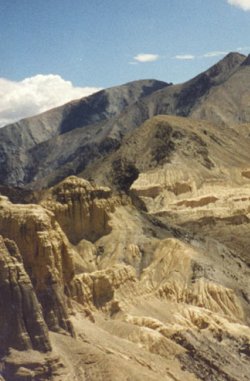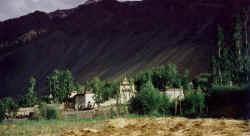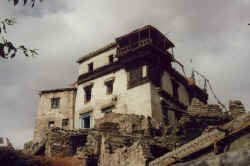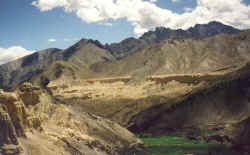MyHimalayasimpressions from |
|
|||||||


Alchi is famous for the paintings in its monasteries. The rural paintings are
the last from the time when Kashmiri artists were spreading Buddhist teachings
with their amazing art.

The location of the village in the green oasis is equally stunning.

hHouse of a more affluent Ladakhi
Indus Valley: Leh - Alchi - Kargil
Leh to Alchi
My cough still worries me, but I have a few days before the trek to get better. Trekking in this condition would make it a lot harder and less fun. We take a taxi to get to the starting point of our trek. Padum lies between the Zanskar range and the Himalayan range. We should be there in four days. I enjoy what I think will be the last hot shower for two weeks. We leave in the morning and follow the Indus westwards. The river disappears into a gorge, which totally changes the landscape. There are no fields for almost one hour and hardly any people live here.
Suddenly a small village can be seen at the end of a valley on the right hand side. That's Phiyang. I'm a bit cranky and not too eager to see another monastery. A big festival will be happening next month, so many people are busy repairing and repainting the monastery. The atmosphere isn't very solemn and I'm having a 'monastery tantrum'. Luckily Phunchok notices that and spares us a few buildings. The Gonkhang is very unusual because the statues aren't covered. It's easy to imagine what kind of effect these big scary creatures have on humble pilgrims.
After a short and steep climb the road slopes down in many curves. We get to Nimmu, the village where the Zanskar river from the south flows into the smaller Indus. In winter it gets so cold here that the surface of the Zanskar freezes and people walk on the solid ice to go from Zanskar to Ladakh. It's often the only way out of Zanskar, too much snow making crossing the passes dangerous or even impossible. But I assume walking on the river is risky, too. At least for European standards. Suddenly there's a strange noise and the car slides for a few metres. Did a tyre blow? We get out, the tire looks all right. But the wheel is barely attached to the axle anymore. Luckily this didn't happen ten minutes earlier to one of the front wheels on the way down from the pass!
In India being a driver also means being a mechanic. Our driver just takes the tools, gets out of the car and tries to fix it. We might be lucky and be able to continue our trip as planned. But a special screw is needed. So we sit down and wait. Since we're on the main road there should be some vehicles coming by. And actually after only a few minutes cars and buses can be seen. Most of them stop when they see our car without our driver having to yell at them. Their driving might seem reckless and dangerous, but solidarity on the road is big and other drivers are very helpful. The first few vehicles don't have the part we need, but a public bus has the right screw. The most technique-savvy guy crawls under the car, while five people (not including us tourists) sit around him and give advice or just watch.
Everything seems okay now, we get in and drive for 20 minutes, reaching the town of Basgo, when... yes, you're right. We almost lose the wheel again. At least we're in a town now, there are things to look at. The valley is very fertile, the steep red rocks which mark the natural barrier to the north. The town itself is a bit dull; considering its long history I expected more. There used to be a big fort on top of the but only ruins are left now. In the 11th century Ladakh was divided into a western and an eastern kingdom. Basgo was the capital of western Ladakh, Shey its eastern counterpart. Many wars were declared here and won; in the 15th century eastern Ladakh was conquered and the capital was moved to Leh. We don't visit the ruins, the car might be fixed anytime soon. It isn't and we have to find another way of getting to Alchi, 40 km westwards. Phunchok tells a taxi driver who is headed in that direction to send two taxis up to Basgo. More waiting, I'm still sick and sitting here doesn't make it any better. Our plan was to visit Likir, a picturesque town with a highly interesting monastery between Bargo and Alchi. There won't be any time for that now.
By the time the taxi gets here I don't want to go anywhere else than straight to the hotel anyway. I try to sleep on the way there, but the driver listens to horrible Indian folk and pop music. The stereo must be broken, the bass is too deep and so loud that it makes the rear seat vibrate. After a minute I get out my walkman and put in the Youth of Today / Judge tape. Ahh... what a salvation. Two hours later we get to Alchi, I go straight to bed and sleep for three hours.
It's a sunny evening and I stroll through barley and wheat fields for half an hour. Later we visit the monastery of Alchi. From an art history point of view it's one of the most valuable ones. Most buildings date back to the 10th century when Kashmir influenced Buddhist art and craft in the region. When Muslims took over Kashmir, much of its culture was wiped out. Alchi is one of the few places where many aspects of that culture can still be seen. Unlike most other temples in Ladakh, Alchi isn't built on top of a hill but lies between fields and trees near the Indus. The famous Rinchen Zangpo founded the monastery and ordered Kashmiri artists to come to Ladakh. They were particularly well-known for their paintings and wood-carving. Ladakhis were also good painters, while the great smiths and builders of statues came from Nepal.
The different architectural style is best seen at the Sumtsek, the oldest building. It's three stories high and build entirely out of wood. Inside is a chorten and a statue made out of clay. I didn't know that clay lasts so long, it's also 900 years old and still in perfect condition. Until recently not many efforts were taken to protect this great monument. The wooden parts suffered from the weather, the roof leaks and the damp had damaged much of the mural paintings. Some have been restored and repainted and look fantastic. The paintings in the front court of the assembly hall tell you even more about its origins. They were done in great detail, which can be seen even today. Palm trees indicate that the artist didn't come from here. Man wear baggy breeches and have moustaches. Battle scenes include soldiers on elephants. I have seen elephants in Hindu temples in India, but I've never heard that they were used for fights. Even I can see the oriental influence. The wood carvings over the entrance are also excellent and show the life of prince Gautama Shakyamuni, the Buddha. The paintings inside have suffered badly from the damp, the hall isn't really used anymore. Only a handful of monks live here.
The village of Alchi is wealthy due to the fact that the climate in this valley is very favourable. Barley can be harvested twice a year and even wheat can be grown. Gardens look like gardens in Switzerland, which seems unbelievable if you consider that we're at 3'500 m .
Ladakh is famous for its apricots; no less than 10 different kinds grow here. They are eaten straight from the tree in summer; some are cooked to make jam, but most of them are sun-dried for winter when food is scarce. The most important staple food for centuries was tsampa, a sticky batter made out of barley. It is the only grain that grows up here, but it can't be used to make bread. Therefore people grind into a flour, which is roasted and then mixed with water and salt. That's tsampa, a rather dull food. Today many people eat rice, which is subsidised by the government.
People often think that Buddhists are vegetarians, but that's a fallacy. Buddhists are allowed to eat meat, but they're not allowed to kill animals. I find this rather contradictory, but I can understand that people eat meat. At this altitude where only few plants grow and there's no much to eat in winter, meat is (or maybe used to be) a life necessity. Most families have a few cows, sheep or goats. They are kept mostly for their milk, but when they're old they are slaughtered, or brought to a butcher (who is often a Muslim). Ladakhis make butter, yoghurt and cheese out of milk. The butter is used for the famous - and by tourists often hated - butter tea: black tea with salt and butter. Another famous drink is chang, a beer made out of barley. Every family has its own recipe and makes its own beer. Chang might be almost non-alcoholic water in one house and taste like strong liquor in the neighbour's house.
Alchi to Kargil
In the morning a bus picks us up to bring us to Kargil. It's an eight-hour drive with few attractions. One of those is the road itself, especially the first part which leads to Lamayuru. Endless curves take us up the steep pass. How much time and money it must have cost to build this road. I doubt there would be any roads if it weren't for their military importance. Before roads were opened to tourism in 1972 it was almost impossible to get to Ladakh. These days it's not only military trucks that use the road, it's mainly lorries that bring up all kinds of goods from Srinagar or from even further away. Traffic is very heavy. The roads are very narrow. More than once we have to drive backwards to let a military vehicle pass, with only a few (too few for my taste) inches to the precipice.
Shortly before the Fatu pass lies Lamayuru, one of the oldest monasteries in Ladakh. It's a lonely place, the closest villages are far away. Far below the monastery is the valley, green fields and a very light rock formation. The white sandstone has been formed by rain and wind and look like chimneys, a very bizarre landscape. People call this part moonvalley. Legends say that a lake surrounded the monastery hill. Demons that looked like snakes (Nagras) lived there until the Buddhist ascetic Arahat Madhyantaka put them to flight. He had put some seeds on the water, later the plants that grew formed a swastika, a sign of Buddha. The Nagras saw that they had lost and fled. Hinduism has huge battle epics, fights in Buddhism seem to be more peaceful. The swastika is a very old symbol originating from India. Swasti is Sanskrit word which means 'well-being', so it doesn't have the bad meaning that comes to mind when you first see that symbol. Geologists have found out that there really was a lake 20'000 years ago, about 3'500 years ago the water flew into the Indus.
The history of the monastery begins in the 11th century, when the Indian yogi Naropa came here to meditate in a cave. Rinchen Zangpo, the great architect, made Lamayuru what is it today when he built five buildings here. Shortly after completion, 400 monks settled down. In the 15th century the abbots were regarded so highly that they were working as consultants for the king. Out of gratitude the monastery was given autonomy, Lamayuru had the right to give asylum to criminals and absolve them (only if they could reach the monastery, of course...) Today about 150 monks of the oldest Buddhist sect study in the monastery.
Quite a few tourists sit in the assembly hall and watch a ceremony. But unlike those people in Hemis, the audience doesn't disturb the ceremony. I don't feel like an intruder and sit down to watch for ten minutes. Texts are recited and music is played. But I don't exactly know the meaning of it all, so I feel like a dumb watcher. In one corner four monks make a mandala out of sand. To a non-Buddhist a mandala may look like a complicated drawing with many colourful circles and squares. Buddhists see a deep meaning in the mandala and use it as a tool for meditation. The mandala visualises different gods (where the gods themselves are only used for visualisation) which helps the monk to turn into a specific god and experience an aspect of Buddha's doctrine. For sand mandalas, grounded precious stones and coloured sand are filled into small funnels. The small hole in the funnel lets the monks draw very precise lines. A finished mandala is breathtaking, even though it's two-dimensional it seems three-dimensional. The creation of such a work of art takes about a week. Shortly after finishing it, it's destroyed. This is a shock for most western tourists. But since the mandala has served its purpose there's no need to keep it. And one of Buddhist's most important mottoes is that everything is transient and holding on to feelings, people or things is a impediment to finding enlightenment. The Swiss psychologist C.G. Jung has spent some time analysing mandalas and found out that many people dream and think in patterns similar so mandalas. He saw mandalas as archetypes of the human psyche.
A hole in the wall lets us look at the small cave of Naropa. He lived from 1016 to 1100, his teacher was Tilopa, his most important student Marpa. Marpa's most famous student was Milarepa, maybe the most-liked yogi. He wrote many stories and poems, many of whom play an important role in Tibetan literature even today. In another room a monk forms figures out of coloured butter, which he works as if it were Plasticine. These are often put on the altar as offerings. How long do they last? I've seen some which are said to be fifteen years old.
We have lunch at a cheap, shabby restaurant where all the truck drivers eat. After finding a few pieces of hair in my rice, my lunch is over pretty fast. The only interesting thing during the four hour drive to Kargil is Mulbekh. This village is the cultural border between the Muslims in the west and the Buddhists in the east. A big sculpture, carved into the rock, is what had made this town famous. The statue is from the 7th century and 23 feet high. Art historians think it's the most valuable sculpture in western Tibet. A big tree grows in front of the statue, but if you're too close you have to look too far up and can't really see it either. I hoped for more after the dull drive. Of course the landscape has been terrific since we've left Leh, but it can't catch my attention for a whole day.
Kargil itself is a very ugly city, it looks rather new with its brick buildings with corrugated iron roofs. But despite the fact that it is old, there's nothing of interest for tourists. So I just stay in our not very nice hotel. Kargil is a Muslim city and since it's not as hard to reach as Leh, the mix of races is even more stunning than in the Indus valley. Some men look like southern Europeans, some have faces which remind me of men from the Balkans, there are Tibetans, Indians, Sikhs, Kashmiri, and some older men look like Mudjaheddins from Afghanistan. Only very women are on the streets. I wonder if they look as different as the men, but I can't tell because most of them wear a scarf.
Most of the things I've read about Islam were rather negative. I don't know whether all the writers were biased or Islam really is worse than other religions. Islam doesn't approve any other god than Allah, who decides whether somebody is going to heaven or hell after death. Muslims disapprove Hinduism because of its many gods. That also goes for Buddhism, which isn't surprising if you consider that Islam doesn't allow the depiction of Allah. Prophet Mohammed founded it, and when he died in 632 AD almost everybody in Arabia was already a Muslim. Believers were asked to spread Islam, if necessary by sword. In the 12th century the north of India was conquered and Indian merchants spread it all over South East Asia. There are two main Islamic groups. Sunnits are more liberal, while Schiits are conservative. Most Muslims in Ladakh belong to the more tolerant first group, which makes peaceful coexistence with Buddhists possible.
I've never had any bad experiences with Muslims, but contacts have been very rare. They seem to avoid foreigners, which is their right, I don't have a problem with that. But their society seems very male-oriented, and I do have a problem with that. How much can be justified in the name of tradition?
|
Summary Part 2:
After three days around Leh we take a taxi and drive west to Kargil. The pleasantly located village of Alchi is famous for its monastery. The rural paintings are outstanding and the last reminder of the great period of Buddhist Kahmiri art. The contrast of yellow wheat fields and black rock faces in the evening light is remarkable. The highlight of the drive is Lamayuru. The white buildings of the monastery rise above the moonscape. Apart from small villages and their fields the scenery is completely barren. Kargil is not a nice place, and often being shelled by the Pakistani army does not increase its charm. |
